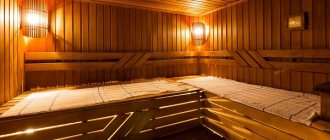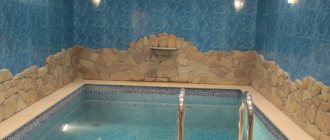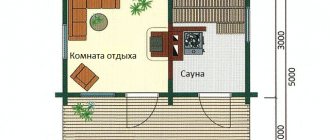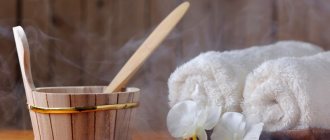Bathhouse - this magical word evokes only positive emotions in most people: wooden benches with a special aroma inherent only to steamed wood. And what is it worth to stay in the steam room! These feelings cannot be forgotten. And pouring cold water, the aroma of an oak broom, a copper ladle and hot steam... Many residents of Russia are accustomed to visiting a traditional Russian bathhouse and call all types of bathhouses by this name. But each such institution has its own differences. Let's look at each one separately.
Russian bath
It can be compared to steam, but the temperature is higher and the humidity is higher. It is reminiscent of a wooden house in which stones are heated and water is poured over them to produce steam. The session lasts 10-15 minutes, then you leave the steam room and either simply relax (cool down) in the dressing room, or you can go to a pool with cold water or wipe your body with snow. There should be several such visits, because the duration of a Russian bath should be at least 3 hours. It is recommended to drink plenty of water or herbal tea during the session. A very important element of the Russian bath is massaging your body with brooms with leaves from various trees, this warms the body faster, improves blood circulation, and gives the effect of the aroma of the sauna. And don't be afraid, it doesn't hurt.
Differences in heating types
Currently existing types of baths and saunas operate at high temperatures.
Warming up to give each bath a special microclimate can be as follows:
- Hammam bath . Heating occurs through pipes with heated water. They are placed under walls, floors and beds. The heat produced very quickly warms up the steam room to the desired temperature. The disadvantage of such a heating system is its high cost and complexity of installation. But the construction of hammams in our country is becoming increasingly popular.
- Russian bath . As a rule, this bathhouse has a closed stove with a brick heater. Such a stove takes a long time to heat up, but the heat is retained for quite a long time due to the properties of the brick and the stones placed in the stove. In a Russian bath you can install a steel stove equipped with a brick screen. The higher it is, the better the heat accumulation properties of the stove.
- Finnish bath and sports sauna . A distinctive feature of such baths is their high temperature, which is easily achieved with a metal stove. In this case, we are not talking about long-term heat retention. In addition, the Finnish sauna is the most affordable type of heating.
- Water bath . The water is heated using a wood-burning metal stove installed directly in the ofuro barrel.
Turkish bath (hammam)
Unlike a sauna, the humidity in a Turkish bath is about 100% and the temperature is from 25 to 50 degrees. Heat rises from the floor. The temperature is lower than in a Finnish sauna, which means that you are more comfortable in a Turkish bath and you can be there longer, and sweating is much more intense. Due to lower temperatures and an increase in the amount of steam, hammams do not have wooden interiors - there is no pleasant woody smell, like in a sauna. At the same time, cleaning a hammam is easier than a sauna. The advantage is that this does not allow a large number of bacteria and fungi, which love heat and humidity, to accumulate there.
Ideally, it is best to visit each type of sauna to see what is right for you. After all, the most important thing is to receive a healing procedure and enjoy the process. And when you feel discomfort, it is difficult to have fun. The sauna is relaxation for the soul and body. Decide on your favorite type of sauna, enjoy and be healthy!
You can read about the benefits of sauna and bath in my previous article “Sauna and Bath.”
aroma saunabathinfrared saunaparrussian saunasaunadry saunatemperaturewarm Turkish bathfurakohammamSwedish saunaJapanese sauna
- Share:
How baths differ in microclimate
The following main types of baths can be distinguished:
- Steam bath - Turkish hammam . The temperature, as a rule, is 40-45 oC, and humidity reaches 90-100%. A distinctive feature of such a bath is the softness of its microclimate, achieved due to low temperature and almost absolute humidity (for more details: “How a Turkish hammam is designed - about construction and properties”). In the hammam you can relax and undergo various beauty treatments.
- Steam sauna - Russian bath . In it, the temperature ranges from 45 to 70 ° C, and the humidity barely reaches 40-65%. In this case, the temperature and humidity indicators are somewhat different. This microclimate causes steam to condense on the skin, thereby creating a film of water. Due to the greater thermal conductivity of water, the body heats up more than in a dry-air sauna at the same temperatures.
Ersatz baths
Some ethnic groups use fairly simplified types of bath procedures. What kind of baths are there, made in this rather primitive way? Let's focus on the most significant ones.
Temazcal - house of hot stones
Temazcal is a traditional Indian bath that has gained wide popularity among the tribes inhabiting the Yucatan Peninsula. This type of steam bath is a round structure sunk into the ground about 1/4 of the height; in the central part of the dome there is a small hole for smoke to escape. The height of the room is approximately 150 - 160 cm and does not allow a person of average build to stand up to his full height. The small door is oriented to the south, the hearth is filled with stones of volcanic nature.
The heating of such a bath was carried out according to the principles of the European black bath. Hot stones served as a source of steam generation. Brooms were in use, but not birch or oak, but maize, from the local variety of corn. Similar simplified baths were used by geologists and tourists, using dense stones as a heat accumulator, and a tent as a steam room. In general, the world is developing in a spiral and we must proceed from the fact that there is nothing unique and inimitable. Although no, what is unique is.
Bathhouse in a Russian stove
One of the brightest and most unique examples of an ersatz bathhouse is a bathhouse in the cavity of a Russian stove. This perfectly illustrates the answer to the question “what is a bathhouse without a bathhouse.” Evil tongues claim that this phenomenon arose from the traditional Russian laziness of heating a bathhouse separately, and the stove, whether you like it or not, must be heated. In general, on a bath day, the heat was removed from the stove, the chimney damper was closed, the inner walls were doused with water, boards were laid and the steam baths, in this somewhat castrated form, received their visitors. In justification, it is worth saying that the process could have been led not by laziness, but by a shortage of firewood in the treeless steppe regions.
The benefits of visiting a bathhouse
For a long time, baths served for the majority of our population as practically the only method of observing and maintaining body hygiene. However, as hot water supply expanded and almost every family had the opportunity to wash daily in their own bathroom, the popularity of baths decreased somewhat, but then began to grow again, albeit in a slightly different quality. And that's why.
It should be understood that all types of baths and saunas existing and used today are an effective tool for healing and stress relief. People who regularly visit them get sick less and live longer. This is not just an opinion common among the majority of our fellow citizens, but a very real fact, repeatedly confirmed by objective medical research. Also, facts indicate that for residents of territories with a continental climate, which includes most of Russia, visiting a Russian steam room is most beneficial.
True, there are a number of diseases for which visiting a bathhouse is not recommended for people suffering from them - for example, for people with heart disease, and for some skin diseases. There are many contraindications.
But the reasons for Russians’ love for bath procedures are by no means limited to health considerations alone. For many peoples, any type of baths and saunas is not only an opportunity to undergo wellness treatments, but also an opportunity to meet and chat with friends in a relaxing and cozy environment. But the frequent desire to combine bathing procedures with copious amounts of alcohol is difficult to approve.
A shot of vodka after the end of the procedure, according to the behest of the brilliant Russian commander Suvorov, or a glass of beer - this is the threshold that should not be crossed. It’s better to limit yourself to high-quality tea. In general, no matter what specific bathhouse you go to, it is better to abstain from alcohol and enjoy the healing steam.
Georgian baths
Such hygienic buildings are based on the use of steam, which comes from hot springs located in the mountains.
Water is also taken from them. Ceramic pipes are used to supply it to the bathhouse. The water flows into large pools lined with marble. As a rule, baths were located in large grottoes. Antique torches were used to illuminate them, which emphasized the indescribable atmosphere of sulfuric water, over which smoke billowed.
In addition to performing its main function - healing, the traditional Georgian bathhouse acted as a restaurant establishment. Here they gathered for business meetings and simply spent time eating.
In modern Georgian baths, along with bath procedures, massage using a special hard mitten made from wool is popular. In addition, the work of a choir performing Georgian songs in such baths is considered an interesting addition.
American Bath – Temescal
The inventors of this method of washing were the Mayan Indian tribes, from whom the tradition was passed on to other tribes (for example, the Aztecs). Temescal is a small hut, in the center of which there was a pit with heated stones (later small stone ovens began to be built in this place).
The stones were watered, 2-3 people in the hut were steamed using herbal brooms, and after the procedure they were washed with cold water. In large cities, bathhouses were also multi-room, there were both steam rooms and swimming pools. To this day, such baths continue to exist in traditional villages in Mexico.
Roman bath
In a Roman bath there are always two separate rooms. In the first, which is called “tepidria”, the temperature stays at about 40 degrees. In the second, which is called “laconium,” a person needs to be in order to sweat well. In this room the temperature is always about 70 degrees. Air enters the bathhouse through special holes, which are located both in the floor and in the walls of the bathhouse. For complete and maximum enjoyment of the bath, various aromatic oils and herbal tinctures are usually added to the steam.
In a Roman bathhouse, as in a Russian one, there are always benches arranged in the same way.
Finnish sauna: relax according to the rules
Finnish healing process consists of three ingredients: mouth breathing, leisurely conversations and the absence of emotional outbursts. It is best to steam in 2-3 sessions of 10 minutes each, taking breaks of 5-7 minutes between them. And don’t try to immediately conquer the top shelf - get used to the heat gradually, enjoying it, and not trying to conquer your body.
After the steam room, immerse yourself in cold water (for beginners it is better to stand in a warm shower), get a massage, drink a herbal decoction or natural juice, and soak your feet in a bath based on herbs.
And remember: proper and regular visits to a Russian, Finnish or Turkish steam room will help you overcome many chronic diseases, improve body tone and raise your body to a completely different level of perception of the world.
Temperature increase method
In the varieties presented above, the temperature is increased with special devices. The steam bath is heated by water pipes that are laid under various surfaces of the room.
In other types of steam rooms, stoves can be used. They also differ in design and heating principle.
What types of sauna stoves there are should be considered in more detail. The steam sauna uses a brick indoor heater. Sometimes a metal stove lined with a stone casing is used. Metal types of heaters are used in dry and wet saunas. To prevent the temperature from dropping quickly, stones are placed inside the iron sheathing. They gain heat and release it into space for a long time.
The water bath uses a wood-burning metal stove. It is in a barrel of water.
Japanese bath
Let's start the review of baths with the most exotic and especially different from its “brothers” in the design and procedures of the bath - the so-called Ofuro. In terms of its usefulness and relaxing properties, it surpasses the Japanese
Ofuro is very difficult, since during this procedure there is no significant overheating of the body, and the water and atmosphere are filled with the aromas of herbs, beneficial plants and relaxing oils. Doctors and traditional healers have long known the fact that the most actively beneficial components of plants are absorbed through the skin.
Japanese Ofuro is a wooden container, on the bottom of which useful herbs, flowers, sawdust, etc. are laid out. A person is immersed in this container, up to his neck in water soaked in herbs. From below, the water is heated to a temperature of 55 degrees. Stay in heated water for no more than 20 minutes. Such bathing is useful for frequent colds, arthritis, and increased fatigue. You don't have to go to Japan to enjoy hot water bathing. This service is quite successfully offered in modern spas.
Irish bath
Such a bath is considered very comfortable, since the steam room is very similar to a Turkish bath. The temperature here is exactly the same. The difference from other baths is that before entering the steam room you should take off all your clothes and, like this, stay in a special room for some time in order to get used to it. After this, the masseur will thoroughly massage the whole body and then you can go to the steam room. After the steam room, you need to cool your body with water poured over yourself from a bucket or take a contrast shower. Then you should go to the massage therapist again.
Indian bath
The Indian bath is considered one of the oldest varieties.
It is still used for health purposes by admirers of Ayurveda today. The classic Indian bath is a whole ritual of sequential actions. It consists of the following stages:
- Preparing for the cleansing ritual
. At this stage, you should prepare the waiting room - turn on quiet music for relaxation, prepare an aroma lamp, light candles. - Lashley stage
. This is a foot washing procedure. A special small foot bath is being prepared. Whey and rose essential oil are added to warm water. During the ablution process, the specialist must massage the legs, use acupuncture points and influence the entire body through the feet. - Udvartana
. At this stage, the entire body should be rubbed with sesame oil. Afterwards, a special herbal powder prepared according to Indian traditional recipes is rubbed into the skin. It is quite difficult to prepare it yourself, because it contains up to a thousand different medicinal herbs. However, you can limit yourself to your favorite herbs that you have on hand. They need to be ground into dust in a mortar before use. - Actually the Indian bathhouse Swedana
. At this stage, the person is placed in a special wooden box. At its bottom there are containers with herbal decoctions, which are heated by a stove located outside. A special grille-partition is placed on top of these containers, through which steam enters the cabin. The svedana is closed with a foil-lined lid. The head remains outside. The procedure lasts about 20 minutes. This time is enough for your body to be saturated with the healing powers of herbs. You can stay in swedana while sitting or lying down. - Recovery
. At the next stage, the person must recover from the steam room. You need to take a shower, wash off the sweat and remaining herbs. - Abhyanga
. This is a special massage after an Indian steam room. It is done with four hands. - Shirodhara
. This is a calming and relaxing procedure. It consists of pouring heated sesame oil from a certain height onto the “third eye” area in the center of the forehead.
At the end of this lengthy ritual, Indians offer to drink herbal tea to restore water balance in the body. You can feel the healing power of swedana in modern conditions - many spa salons offer this service.
Hammam – steam bath
A Turkish bath is called a hammam. The predominant type of microclimate here is called a steam bath. In its shape it resembles a palm. The round room in the center is the bathhouse. The corridors leading to it are like fingers. Using them, visitors can get to different steam rooms. They maintain different temperatures. Visitors go through all the premises.
Next you need to go to the room with sun loungers. They differ from those used in Russian and Finnish saunas. Studying the types of steam rooms, one cannot help but say what kinds of benches there are for a bath. They are heated in the hammam. They are made of stone and decorated with mosaics.
After a good warm-up, a person can move on to a room with the lowest temperature. Here he gets a massage. Next, visitors wash themselves and go to the pool.
Infrared sauna
Having considered what types of baths there are, one cannot help but pay attention to one of the new varieties. This is an infrared sauna. Its popularity is explained by its small size and the way it affects the body. The booth in which the procedure takes place may be very small.
The infrared heater affects the surface of the cabin and the human body. The emitters inside are located in a special way. This allows infrared rays to penetrate up to 4 cm under the skin and reach very deep layers. With normal heating, this effect cannot be achieved.
Stimulates fluid turnover in tissues and blood circulation. At the same time, the muscles are trained, the elasticity of blood vessels increases, and the tissues are saturated with oxygen. But the positive effect will become noticeable only after several procedures. During the session, the body requires plenty of fluids. Sweat should be wiped off with a towel. Otherwise, infrared rays will not be able to penetrate deeply into the body. Having considered what types of baths there are, you can choose the best option for yourself.
Greek bath Lakonium
Laconium has relatively low humidity, not exceeding 30%, and the temperature background is around 50* on average. It is in the Greek bath that people with heart ailments feel comfortable, because the load on the heart is minimal. The body warms up evenly. Greek laconium accelerates metabolic processes, relieves pain in joints and muscles. Important aspects such as mood, sleep, and respiratory activity return to normal after visiting a Greek bath. Laconium is very popular among athletes and people who are passionate about physical activity.
Contraindications : diseases in the acute stage, oncology.
Russian steam room
In an ordinary Russian steam bath there is quite high air humidity and no less high temperature, reaching 120* Celsius. The heat in a traditional steam room comes in waves, providing profuse sweating and deep warming. The effect of a Russian steam room is achieved by using an additional item - a leaf broom. Thanks to the plant substances contained in the broom leaves and twigs, when steaming, a kind of massage occurs, during which the recovery processes in the body are accelerated, the pores open, the blood vessels are trained, and the skin is renewed. The Russian bathhouse treats ailments such as radiculitis, lipid metabolism disorders, autonomic and nervous disorders, chronic skin diseases and menopause.
Contraindications : pregnancy, acute and chronic heart disease, hypertension, ARVI, oncology.










